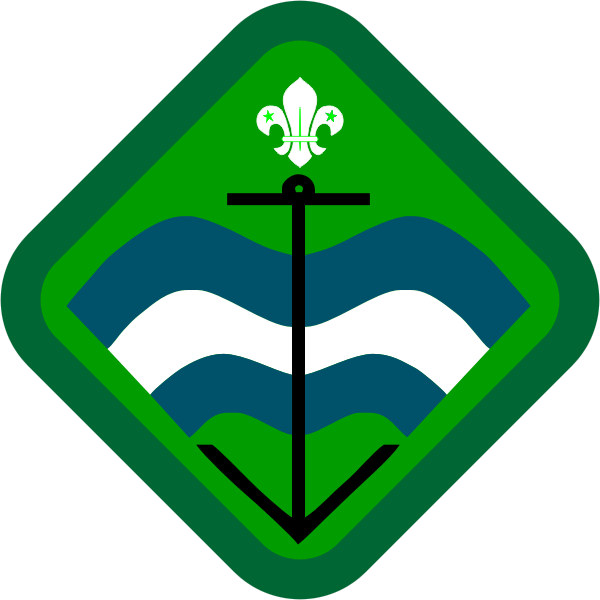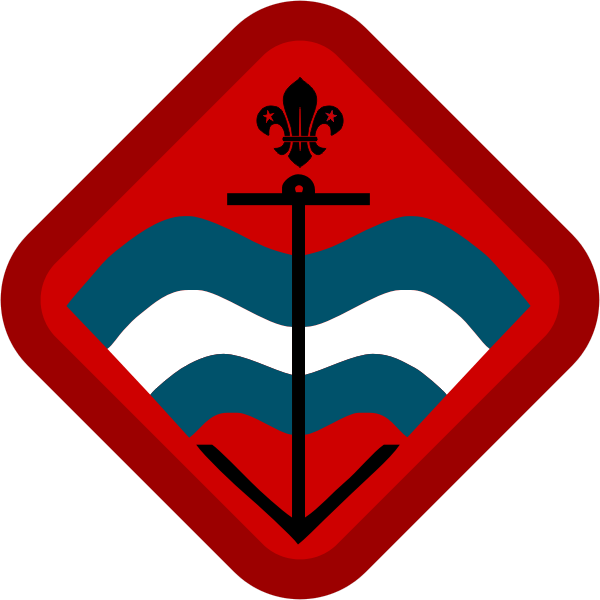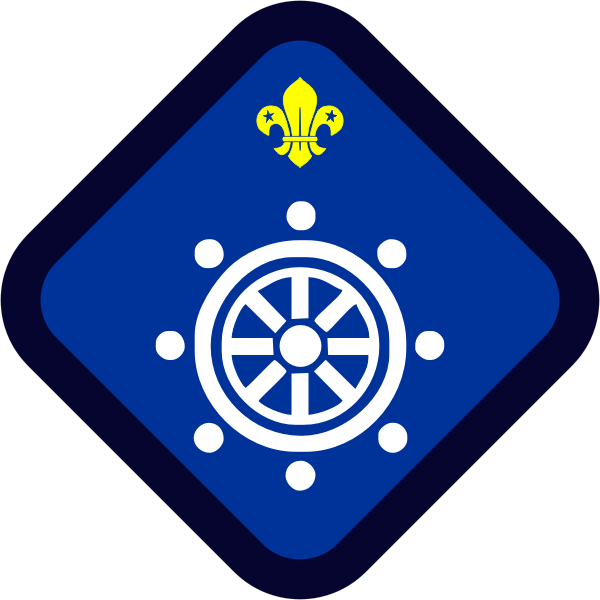




Seamanship
Junior Seaman – Green Background (Previously Boatman)
- Swim 50 metres and stay afloat for five minutes,
- Explain the safety rules that apply to boating and the effects of winds, tides and current.
- Explain the difference between a buoyancy aid and a lifejacket. Adjust to fit and wear one to enter the water from a height at one metre.
- Name the parts of a boat and its equipment, prepare it for a water activity and use it.
- Have some knowledge of rescue by boat.
- Demonstrate, whilst afloat, the following and their correct uses: reef knot, sheet bend, double sheet bend, round turn and two half hitches, fisherman's bend, bowline; make a sailmaker's whipping.
- Heave a lifeline from a boat, to land within reach of a target eight metres away, twice within three attempts.
- Row a dinghy single-handed and carry out basic manoeuvres.
- Scull a dinghy over the stern and carry out basic manoeuvres.
- Be able to steer and manoeuvre a boat, canoe or dinghy.
- Take part in a half day's exercise afloat to show that you have prepared yourself for boating; have pursued the basic skills of boatwork, and be able to carry out a simple rescue operation by boat.
Note:
During the training for this badge, it is intended that the opportunity should be taken to undertake some canoeing and sailing as a member of a crew.
Seaman – Red Background (Previously Coxswain's Mate)
- Hold the Junior Seaman badge and be working on the Trail Award.
- Have a knowledge of the steering and sailing rules; local rules; distress, storm, fog and danger signals.
- Have some knowledge of rescue by boat or canoe and be able to carry out a simple rescue exercise.
- Demonstrate capsize drill and using a training manikin demonstrate the correct method of ventilation.
- Know how to obtain weather and understand their importance.
- Hoist the colours for a Sea Scout Group. Pipe the 'Still' and 'Carry On' on a Bosun's Call.
- Demonstrate how to take soundings in local waters, both with leadline and pole.
- Complete the following activities:
- With other members of your Patrol, clean and paint a boat.
- Assist with repairs to a boat.
- Make an eye splice and a short splice.
- Demonstrate, whilst afloat, the following and their correct uses: clove hitch, rolling hitch, fisherman's bend and a form of stopper knot.
- Take charge of a boat's crew and carry out basic manoeuvres including anchoring and taking a small boat in tow.
- Rig a sailing boat and name the parts of the gear.
- Show that you are an efficient member of a sailing crew and take the helm and sail the boat on all points of sailing including getting under way and coming alongside.
- Acting as an assistant in a rescue exercise, board a stranded craft and bring it ashore single-handed.
- Form part of a crew of a pulling boat for an expedition of not less than 24 hours duration, to include a night spent in camp.
Note:
During the training for this badge, it is intended that the opportunity should be taken taken to obtain some experience in the management of outboard or inboard power craft. Alternatively, a short canoeing expedition in company with other canoeists should be undertaken.
A basic knowledge of chartwork should be introduced during this stage, including some compass work afloat.
Leading Seaman – Blue Background (Previously Coxswain)
- Hold the Seaman badge and be working on the Traverse Award.
- Read a chart and plot a position at sea.
- Have a good knowledge of the following:
- The International Buoyage System (IALA).
- The sound signals used by powered vessels underway or at anchor.
- The navigation lights carried by different types of vessels.
- The effects of currents.
- Discuss the Beaufort Wind and Sea Scales and know at least two natural signs for fine weather and characteristic signs for approaching bad weather.
- Demonstrate the HELP posture for survival in water and with other members of the Patrol, demonstrate the HUDDLE position for survival in water.
- Undertake a repair to a boat using relevant materials.
- Make a rope fender, a boat’s bag, a sail bag, or a decorative piece of ropework, for example a lanyard.
- Send a message of 25 letters over a distance of approximately 330 metres (1.5 cables) between two boats or between boat and shore. Be able to recognise the importance of single letter hoists of the International Code of Signals.
- Take charge of a boat with crew and, in response to a distress call, take the boat away, steer a short compass course and pick up a small object from the water.
- Take charge of a party preparing a boat for sailing, including gear to ensure the safety of the craft and crew under all conditions.
- Be able to sail a boat in any direction on all points of sailing, and be able to tack, wear, reef, make and shorten sail and be able to get under way and come alongside from any direction, anchor safely, and be able to sail up and make fast to a buoy.
- Whilst afloat, make up a form of sea anchor from available materials in the boat, hove to and understand its use in an emergency
- Under sail, demonstrate ‘man overboard’ drill using a suitable object.
- Complete one of the following:
- Take charge of an expedition with a purpose of not less than 24 hours duration and approximately 10 nautical miles distance, under sail or power, to include a night in camp, or sleeping aboard. Evidence of adequate planning in advance must be shown.
- Make a full report of a journey carried out by canoe or small craft, of not less than 30 kilometres. The report is to include full details of two campsites adjacent to mooring places in the area.
